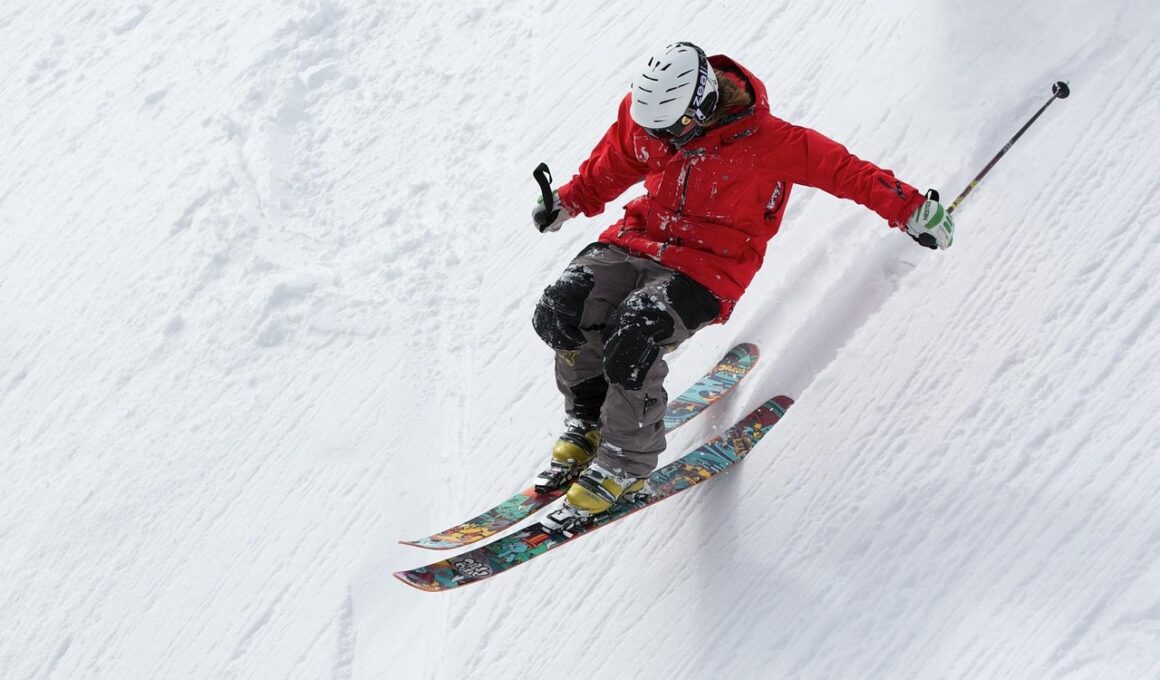The Science Behind Ski Race Training Programs
Ski race training programs are designed to enhance the skills and abilities necessary for success on the slopes. The foundation of these programs is built upon a solid understanding of biomechanics and physiology. Athletes engage in various exercises that target strength, endurance, flexibility, and agility, which are critical components in ski racing. Training typically encompasses on-snow drills, dryland workouts, and mental preparation techniques. Each element works in concert to develop an athlete’s overall performance. For instance, strength training increases power output during skiing, while endurance exercises improve overall stamina on the course. Additionally, agility drills help skiers navigate turns effectively at high speeds. Furthermore, cognitive skills such as decision-making and visualization are trained to help athletes anticipate and respond to course challenges. Such programs can be further enhanced by incorporating technology, including video analysis and performance tracking tools. These innovations provide athletes and coaches with valuable insights for refining their techniques. In summary, ski race training is a multifaceted approach that utilizes scientific principles to optimize athletic performance. By following a structured training plan, athletes can achieve improvements in their speed and efficiency while minimizing the risk of injury.
Understanding the Components of Effective Training
To optimize performance, ski race training programs incorporate a variety of components tailored to the individual athlete’s needs. These components include strength training, endurance training, agility workouts, and skill development. Strength training focuses on improving muscle power, particularly in the legs, core, and upper body. Exercises like squats, lunges, and deadlifts are fundamental in building this strength. Endurance training, on the other hand, enhances cardiovascular fitness, ensuring that athletes can maintain high levels of exertion throughout the race. Ski-specific drills, such as long-distance skiing and interval training, are commonly utilized. Agility training is crucial for developing quick reflexes and coordination, helping skiers to adapt to changing terrains. Furthermore, improving technique through specialized drills can significantly influence performance outcomes. Sessions may also include video analysis to identify areas for improvement. Additionally, mental training techniques, such as visualization and mindfulness, are increasingly recognized as essential components of a comprehensive training plan. By developing all these aspects, athletes can ensure they are well-prepared for the challenges presented on the racecourse. Coaches play a key role in creating a balanced training regime, adjusting as necessary based on the athlete’s progress and competition schedule.
The role of nutrition in ski race training cannot be overstated. Proper nutrition fuels the body and aids in recovery, making it a critical element of training programs. Skiers need to maintain a balanced diet rich in carbohydrates, proteins, healthy fats, vitamins, and minerals. Carbohydrates serve as the primary fuel source during intense physical activity, while proteins are essential for muscle repair and recovery. Hydration is another important aspect; dehydrated athletes may experience decreased performance and increased fatigue. It is recommended that athletes consume a variety of foods to meet their nutritional needs. This includes whole grains, lean meats, fish, dairy products, fruits, and vegetables. Pre- training meals should focus on easily digestible carbohydrates, providing quick energy, while post-training meals should prioritize protein intake to facilitate recovery. Timing of meals is important as well, with athletes benefiting from eating before and after workouts. Moreover, some skiers may choose to work with a sports nutritionist to create individualized meal plans that align with their training goals and schedules. Ultimately, the right nutrition supports optimal performance and can be a game-changer during competitions.
Incorporating Mental Training
Mental training has gained recognition as an integral part of ski race training, emphasizing the psychological aspects of performance. Athletes must contend with pressure and the mental demands of competing at high speeds, making it crucial to develop mental resilience. Techniques such as visualization allow athletes to mentally rehearse skills and strategies, thereby building confidence. By imagining successful runs, athletes can enhance their focus and reduce anxiety. Moreover, mindfulness practices help skiers remain present and calm during races. These practices can improve concentration and foster a positive mindset. Mental conditioning sessions often include goal-setting, helping athletes establish clear, attainable objectives throughout training and competition. This approach fosters motivation and encourages athletes to push their limits. Regular reflection on performance, both successful and unsuccessful, allows for continuous improvement. Additionally, coaches can play a pivotal role in supporting athletes’ mental health by providing encouragement and guidance. By integrating mental training into every aspect of preparation, athletes can achieve greater consistency and improved results on the slopes. Overall, mental preparation complements physical training, culminating in a rounded athlete ready to excel in ski racing events.
Technology contributes significantly to the evolution of ski race training programs. Various technological advancements have been developed to enhance training efficiency and performance analysis. One prominent tool is video analysis, allowing athletes to review their runs and assess performance metrics. By visually observing their technique, athletes can identify areas needing improvement and refine their skills more effectively. Wearable technology, such as heart rate monitors and GPS tracking systems, helps athletes monitor their physiological responses during training sessions. Data can provide insights into performance trends, allowing for personalized training adjustments. Furthermore, virtual reality (VR) training simulations offer a revolutionary approach to skill development, immersing athletes in realistic race scenarios without the physical demands. Coaches utilize these technologies to create detailed reports and feedback, aiding in decision-making. Strength and conditioning programs can also integrate these technologies to provide athletes with tailored workout regimens. In essence, technology’s role is to streamline training processes, provide critical feedback, and ultimately drive performance enhancements. As technology continues to evolve, its integration into ski race training will likely yield even greater results, making athletes more competitive and better prepared for events ahead.
Impact of Injury Prevention
Injury prevention is a crucial element of ski race training programs, as skiing can place significant stress on the body. Developing a comprehensive injury prevention strategy allows athletes to reduce the risk of common skiing-related injuries, such as knee ligament tears and sprains. Training should include specific exercises that strengthen key muscle groups, focusing particularly on the knees, hips, and core. Balance training plays a significant role, as it improves stability while skiing and enhances overall coordination. Flexibility exercises, such as stretching and mobility drills, are equally essential in maintaining range of motion and preventing stiffness. Athletes should also prioritize warm-up routines before each training session, as this prepares the body for exertion and reduces the likelihood of injury. Coaches and trainers should continuously monitor athlete movements, providing feedback on any technique flaws that may lead to injuries. Furthermore, recovery strategies, including rest days, foam rolling, and physiotherapy, are important for overall athlete health. By emphasizing injury prevention throughout training, athletes can maintain consistency in their preparation leading up to competitions. Ultimately, a focus on preventing injuries contributes to long-term athletic development and success.
As the ski racing community continues to evolve, so do the training programs that support athletes’ dreams. Collaborations between coaches, sports scientists, and nutritionists ensure that training remains cutting-edge and effective. Continuous research into exercise physiology and biomechanics yields new insights, promoting evidence-based training approaches. Innovations in equipment technology also influence training regimens, as better gear enhances performance and safety on the slopes. For instance, advancements in ski design and construction can promote better balance and control, allowing athletes to push their limits. Additionally, enhanced protective gear reduces the risk of injury, allowing athletes to train more vigorously. Opportunities to share knowledge and experiences among athletes through forums and workshops can further enrich training environments. Community support is important; it provides motivation and fosters the sharing of successful strategies. As ski race training programs continue to evolve, they will increasingly cater to the demands of competitive skiing, ensuring athletes are better equipped to meet the challenges ahead. In conclusion, the science behind ski race training is an ongoing journey requiring adaptation, innovation, and a commitment to excellence in athletic performance.


